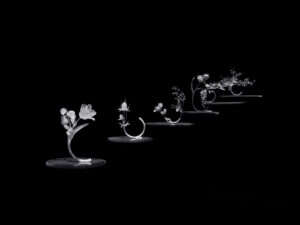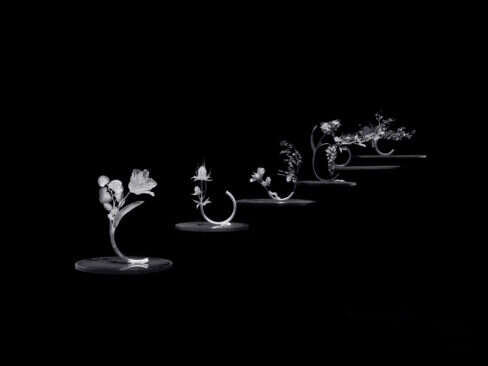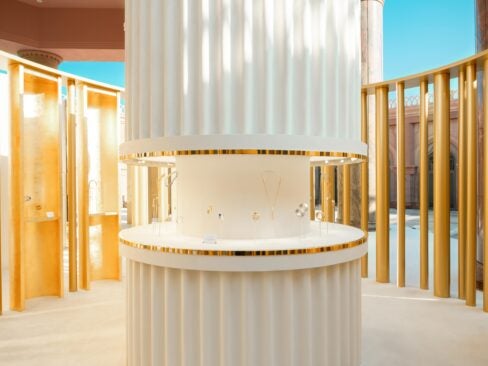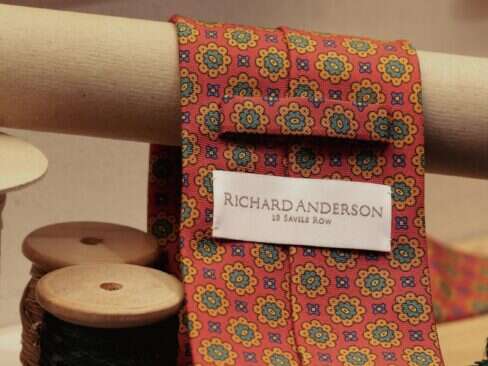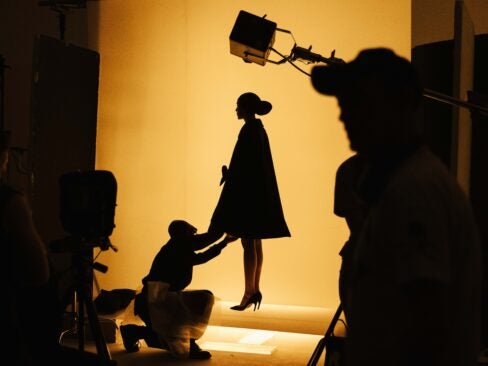Haute couture is the very antithesis of see-now-buy-now fast fashion.
 With each piece individually tailored in sumptuous fabrics to fit the wearer’s body like a glove and employing the most exquisite workmanship, it is the most luxurious way to dress.
With each piece individually tailored in sumptuous fabrics to fit the wearer’s body like a glove and employing the most exquisite workmanship, it is the most luxurious way to dress.
Out of a dressing room, it emerges; a white satin gown that’s more sculpture than garment, its structure and details realized under hands that are more artist than seamstress. Just a day earlier, this dress was sailing down a runway in Paris’s Grand Palais, but it’s the hours after the show when the beauty of a haute-couture garment truly reveals itself. For the woman who favors this pinnacle of fashion, meticulously tailored to her body and made entirely by hand, the thrill is the experience of arriving at the atelier – in this case, Chanel’s iconic flagship at 31 Rue Cambon. Each client will try on her favorite pieces and examine the painstaking workmanship of les petites mains, or little hands, the name historically ascribed to each atelier’s artisans. Here they’re tasked with transforming Karl Lagerfeld’s fanciful concepts into chic reality.
 This gown’s bodice, for example, is lushly embroidered with flowers, but upon closer inspection, each petal is not crafted of silk thread, but of tiny, individually placed feathers. The buttons running down the back likewise fool the eye, each one a mosaic of beads and sequins smaller than grains of rice, inspiring thoughts of the artisan’s patience – and eyesight.
This gown’s bodice, for example, is lushly embroidered with flowers, but upon closer inspection, each petal is not crafted of silk thread, but of tiny, individually placed feathers. The buttons running down the back likewise fool the eye, each one a mosaic of beads and sequins smaller than grains of rice, inspiring thoughts of the artisan’s patience – and eyesight.
Each January and July this ritual repeats itself as the haute-couture collections take center stage in Paris. Conversations inevitably arise about the validity of haute couture in a world so thoroughly governed by technology, and how the customer base for these five- and six-figure garments is dwindling: by some estimates, totaling just 2,000 clients around the globe. If numbers are difficult to confirm, it’s because haute couture remains a business rooted in discretion; unlike red carpets or the high-wattage front rows of fashion shows, haute-couture clients are rarely discussed. Every other sector of fashion lives in the immediacy and transparency of the digital age, but haute couture is the last, most exacting and exclusive private club.
Yet that’s precisely why it should be valued. It’s the antithesis of fast fashion, revered not only for its artistry and handcraft, but also for its ability to inform all the other collections that fall under it. For the designers overseeing houses that include haute couture, this is often where ideas are born, in silhouette, in fabrication, or in the individual aesthetic. For those who can’t afford haute couture, there is undeniable comfort in that trickle-down effect.
 The Fall/Winter 2016 collections made the case that haute couture is undergoing a renaissance, infused with new designers injecting a palpable energy into this old-school art form. For his first-ever couture collection, J. Mendel’s Gilles Mendel employed his history as a furrier to blend details such as shaved mink embroidered as artful swirls on a sheath, a lush texture that paired well with beadings in deep metallic tones. Of course, it’s the gowns that shine brightest in haute-couture shows, such as the ballet-inspired floor-length dress of pleated pink tulle at Giambattista Valli, or the aforementioned floral-embellished gown at Chanel (that Grand Palais set, meanwhile, had been designed to resemble a haute-couture workroom, complete with dress forms transported direct from the Rue Cambon atelier).
The Fall/Winter 2016 collections made the case that haute couture is undergoing a renaissance, infused with new designers injecting a palpable energy into this old-school art form. For his first-ever couture collection, J. Mendel’s Gilles Mendel employed his history as a furrier to blend details such as shaved mink embroidered as artful swirls on a sheath, a lush texture that paired well with beadings in deep metallic tones. Of course, it’s the gowns that shine brightest in haute-couture shows, such as the ballet-inspired floor-length dress of pleated pink tulle at Giambattista Valli, or the aforementioned floral-embellished gown at Chanel (that Grand Palais set, meanwhile, had been designed to resemble a haute-couture workroom, complete with dress forms transported direct from the Rue Cambon atelier).
Elie Saab’s New York-themed collection highlighted Art Deco beadings that evoked thoughts of the Chrysler Building, while feathers on shoulders called to mind birds about to take flight. And at Schiaparelli, design director Bertrand Guyon looked to a legendary collection by the woman who founded the house; Elsa Schiaparelli’s 1938 circus-themed show. Guyon’s evening-driven designs offered up lush animal embroideries on satin and velvet, with accents on defined shoulders that lent each look a distinct modernity.
It’s also notable that Schiaparelli, with its atelier on Place Vendôme, sustains itself as a house solely devoted to haute couture. In a business that increasingly prizes instant gratification, this steadfast resolve to keep haute couture not only alive but also relevant and moving forward should be celebrated. It may be the ultimate proof that fast isn’t always better.
Laurie Brookins is a New York-based fashion journalist and stylist.






